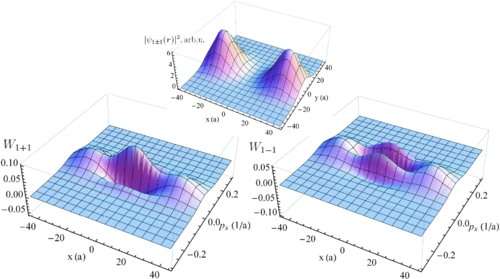Wave properties of particles can manifest in collisions

Dmitry Karlovets, senior researcher at the TSU Faculty of Physics, and Valery Serbo from the Institute of Mathematics of the SB RAS have shown that it is possible to observe the wave properties of massive particles at room temperature in practically any modern physics laboratory—it is only necessary to precisely focus the beam of particles. The results of the theoretical research were published in Physical Review Letters.
Usually the wave properties of particles are well-manifested in physics experiments at low temperatures, for example, in the phenomenon of superconductivity. Because of the necessity to cool the particles, research on the wave nature of matter has been quite expensive. "We found a way to perform an experiment in which the wave properties of the particles occur at room temperature. For this, nothing needs to be cooled, it's just good to focus the beam," explains Dmitry Karlovets.
According to the theoretical physicists, the electron beam needs to be focused into a spot the size of a hydrogen atom. In this case, modern electronic microscopes are sufficient, and are widely available in many scientific centers, including TSU.
"Earlier, scientists thought that the wave properties of particles at room temperature would manifest themselves when focusing into the so-called Compton wavelength. For an electron, this is about 10-13 meters. The size of the hydrogen atom is three orders of magnitude greater, 0.5 * 10-10 meters. This resolution has already been achieved at the University of Antwerp in Belgium," says Dmitry Karlovets.
Further, physicists have shown that the wave properties of particles will manifest themselves particularly clearly if the electrons are in special quantum states. In quantum optics, scientists are able to create microscopic analogs of Schrödinger's cat, a well-known mental experiment about a cat in a closed box with poison. While the cat is unobserved, it is in a state of superposition, in which it is both alive and dead. So it is with waves: When two electron beams are superimposed on each other, they can interfere, that is, either amplify or extinguish each other. In the area of space where destructive interference occurs, the probability for an electron to have a certain coordinate and momentum becomes negative. It is a property inexplicable in the language of classical physics.
"If you shine a simple beam on an atom, then the electrons begin to dissipate, absorb, or do something else. And if we focus such a 'cat' (two superimposed beams) on a hydrogen atom, then in the area between the beams, the atom reacts differently because there is destructive interference," says Dmitry Karlovets. "This leads to a change in the properties of the scattered electrons and can be observed experimentally." Thus, focusing the electrons on the hydrogen atom allows researchers to study purely quantum effects in the collision of particles that have never been observed in particle physics.
More information: Dmitry V. Karlovets et al, Possibility to Probe Negative Values of a Wigner Function in Scattering of a Coherent Superposition of Electronic Wave Packets by Atoms, Physical Review Letters (2017). DOI: 10.1103/PhysRevLett.119.173601
Journal information: Physical Review Letters
Provided by National Research Tomsk State University




















